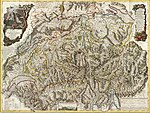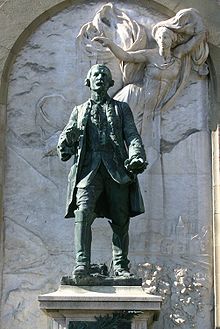Early modern Switzerland: Difference between revisions
→Growth of the aristocracy: added picture, not the best, but all I could find |
→Growth of the aristocracy: added new paragraph |
||
| Line 17: | Line 17: | ||
During this time, changes to the membership of city councils became increasingly rare. Throughout the [[Middle Ages]] a seat on the town council was normally a lifetime appointment<ref name="page93">Flüeler, p. 93</ref>. However plagues, battlefield deaths and conflicts over the Reformation guaranteed a regular turnover in the city councils. During the Early Modern Age, the growing scientific knowledge and relative peace reduced the number of open seats in the cities<ref name="page93"/>. At the same time, council members were increasingly able to fill the council with relatives. During this era, the population in Europe began to expand again following the Thirty Years War. This led to population pressure that hadn't been experienced in several generations. For protection and help against the rising number of immigrants and landless peasents many villages began to draw closer to neighboring towns, eventually coming under the authority of the larger towns<ref name="page93"/>. |
During this time, changes to the membership of city councils became increasingly rare. Throughout the [[Middle Ages]] a seat on the town council was normally a lifetime appointment<ref name="page93">Flüeler, p. 93</ref>. However plagues, battlefield deaths and conflicts over the Reformation guaranteed a regular turnover in the city councils. During the Early Modern Age, the growing scientific knowledge and relative peace reduced the number of open seats in the cities<ref name="page93"/>. At the same time, council members were increasingly able to fill the council with relatives. During this era, the population in Europe began to expand again following the Thirty Years War. This led to population pressure that hadn't been experienced in several generations. For protection and help against the rising number of immigrants and landless peasents many villages began to draw closer to neighboring towns, eventually coming under the authority of the larger towns<ref name="page93"/>. |
||
During the 17<sup>th</sup> Century seats in the councils became increasing hereditary. There were between 50 and 200 families that controlled all the key political, military and industrial positions in Switzerland<ref name="page93"/>. However, the aristocracy remained generally open and new families were accepted if they were successful and rich enough. |
|||
==Conflict and Revolution== |
==Conflict and Revolution== |
||
Revision as of 05:39, 7 June 2008
| History of Switzerland |
|---|
 |
| Early history |
| Old Swiss Confederacy |
|
| Transitional period |
|
| Modern history |
|
| Timeline |
| Topical |
|
|
The Early Modern period of Swiss history, lasting from formal independence in 1648 to the French invasion of 1798 came to be referred as Ancien Régime retrospectively, in post-Napoleonic Switzerland.
The Thirty Years War
While the start of the Early Modern period is the end of the Thirty Years' War, both the war and the Reformation led to the development of the early modern state of Switzerland. The Reformation in Switzerland left the Old Swiss Confederacy divided between two hostile factions. However, Switzerland remained a relative "oasis of peace and prosperity"[1] (Grimmelshausen) while Europe was torn by the Thirty Years' War. The cities generally lay low and watched the destruction from afar, the Republic of Zürich investing in building state-of-the-art city ramparts. The cantons had concluded numerous mercenary contracts and defence alliances with partners on all sides. Some of these contracts neutralized each other, which allowed the confederation to remain neutral — in the 1647 Defensionale von Wil[2], signed under the impression of the Swedes advancing as far as Lake Constance in the winter of 1646/47, the confederates declared "permanent armed neutrality", the historical starting point of Swiss neutrality, which would be re-confirmed by the Congress of Vienna and adhered to throughout the 19th and 20th century conflicts.

Treaty of Westphalia
At the Treaty of Westphalia in 1648, the Swiss Confederacy attained legal independence from the Holy Roman Empire, although it had been de facto independent since the Swabian War in 1499. With the support of the Duke of Orléans, who was also prince of Neuchâtel and the head of the French delegation, Johann Rudolf Wettstein.[3], the mayor of Basel, succeeded in getting a formal exemption from the empire for all cantons and associates of the confederacy. Following the Thirty Years' War, as France grew into a great power in Europe, the newly independent Confederation turned to France for trade and protection. In 1663 the Confederation agreed to a new treaty with France which granted Swiss mercenaries certain rights and protections as well as promised French neutrality in Swiss religious conflicts[4].
During the Thirty Years' War, the Drei Bünde (Graubünden, an associate state of the Swiss Confederation) had been caught in the middle of internal and external conflict. Because the Leagues were very decentralized, conflicts over religion and foreign policy broke out during the war (known as the Bündner Wirren or Confusion of the Leagues)[3]. Following the war the League took steps to strengthen itself. The Valtellina, which had broken from the Three Leagues, became a dependency once again after the Treaty and remained so until the founding of the Cisalpine Republic by Napoleon Bonaparte in 1797.
Growth of the aristocracy

Political power congealed around the 13 cantons (Bern, Zürich, Zug, Glarus, Uri, Schwyz, Unterwalden, Fribourg, Solothurn, Basel, Luzern, Schaffhausen, Appenzell) of the old confederation. During this era, the patrician families decreased in number but increased in power. Some patrician families were drawn from leadership in the Guilds or trading groups within the town. While other families grew from successful mercernary captains and soldiers. The trend toward increasing Authoritarianism conflicted with the history of public expression which grew out of the Swiss Reformation. In many regions the patrician families were unable to suppress the public assemblies but they did dominate the assemblies. The tradition of inviting the people to express their opinions died out mostly during this era[3].
During this time, changes to the membership of city councils became increasingly rare. Throughout the Middle Ages a seat on the town council was normally a lifetime appointment[5]. However plagues, battlefield deaths and conflicts over the Reformation guaranteed a regular turnover in the city councils. During the Early Modern Age, the growing scientific knowledge and relative peace reduced the number of open seats in the cities[5]. At the same time, council members were increasingly able to fill the council with relatives. During this era, the population in Europe began to expand again following the Thirty Years War. This led to population pressure that hadn't been experienced in several generations. For protection and help against the rising number of immigrants and landless peasents many villages began to draw closer to neighboring towns, eventually coming under the authority of the larger towns[5].
During the 17th Century seats in the councils became increasing hereditary. There were between 50 and 200 families that controlled all the key political, military and industrial positions in Switzerland[5]. However, the aristocracy remained generally open and new families were accepted if they were successful and rich enough.
Conflict and Revolution

During the Ancien Régime the nobility of Switzerland grew in power becoming nearly absolute rulers. The loss of power, growing taxes and religious conflicts all lead to uprisings and conflicts throughout the Confederation. In 1646 the town of Wädenswil revolted against Zürich. A few years later in 1653 the largest uprising occurred as peasants of territories subject to Lucerne, Berne, Solothurn and Basel revolted because of currency devaluation. Although the authorities prevailed in this Swiss peasant war, they did pass some tax reforms and the incident in the long term prevented creation of an absolutist state, unlike many of the other states of Europe. Religious tensions erupted in the First and Second Battles of Villmergen in 1656 and 1712. Around 1707 unrest erupted in the city of Geneva which continued throughout the Early Modern Period. Additionally in 1707, the Toggenburg valley rebelled against the Prince-Abbot of St. Gall. From 1719-22 the Werdenberg region rebelled against the city of Glarus.
In 1717 Major Jean Daniel Abraham Davel was appointed the commander of the Lavaux region, which is in modern day Canton Vaud. He identified with the French speaking population that felt oppressed by the German speaking city of Berne that occupied Vaud. Davel believed that he had been called by God to free the inhabitants of Vaud from Berne[6]. On March 31, 1723 he mobilized 600 men and marched on Lausanne to ask the city leaders to revolt with him. However, they reported him to Berne and arrested him on the next morning. He was judged guilty of treason and beheaded[6].
About a quarter century later, in 1749, there was another unsuccessful uprising in Berne against the patrician families of the city. A few years later, in 1755, the unsuccessful Liviner Uprising against Uri. Finally in 1781 the Chenaux Uprising occurred against the city of Fribourg[3].
Age of Enlightenment
The Age of Enlightenment was well received in Swiss cities, in spite of contemporary tendencies towards political conservatism. The Early Modern Era was a time when Swiss science and literature flowered. In Zürich the scholar and physician Johann Jakob Scheuchzer wrote about Swiss history, geology, geography and science. In Basel the Bernoulli family and Leonhard Euler worked on mathematics and physics, coming up with some fundamental concepts in these fields[3]. Albrecht von Haller and Jean-Jacques Rousseau praised the natural beauty and unspoiled state of Switzerland and triggered an early wave of tourism (notably, Goethe's visit to Switzerland in 1775). Zürich at the time was home to a number of internationally known scholars, such as Johann Jakob Bodmer, Salomon Gessner, Johann Heinrich Pestalozzi and Johann Caspar Lavater, styling itself as "Republic" (after the great city states of the time, such as the Republic of Venice).
References
- ^ Thirty Years War in German, French and Italian in the online Historical Dictionary of Switzerland.Error in template * invalid parameter (Template:HDS): "1"
- ^ Thirty Years War, The Confederation and the War in German, French and Italian in the online Historical Dictionary of Switzerland.Error in template * invalid parameter (Template:HDS): "1"
- ^ a b c d e Niklaus Flüeler and Roland Gfeller-Corthésy, ed. (1975). Die Schweiz vom Bau der Alpen bis zur Frage nach der Zukunft. Luzern: C. J. Bucher AG. pp. 67–71.
- ^ Treaties in German, French and Italian in the online Historical Dictionary of Switzerland.Error in template * invalid parameter (Template:HDS): "1"
- ^ a b c d Flüeler, p. 93
- ^ a b Jean Daniel Abraham Davel in German, French and Italian in the online Historical Dictionary of Switzerland.
